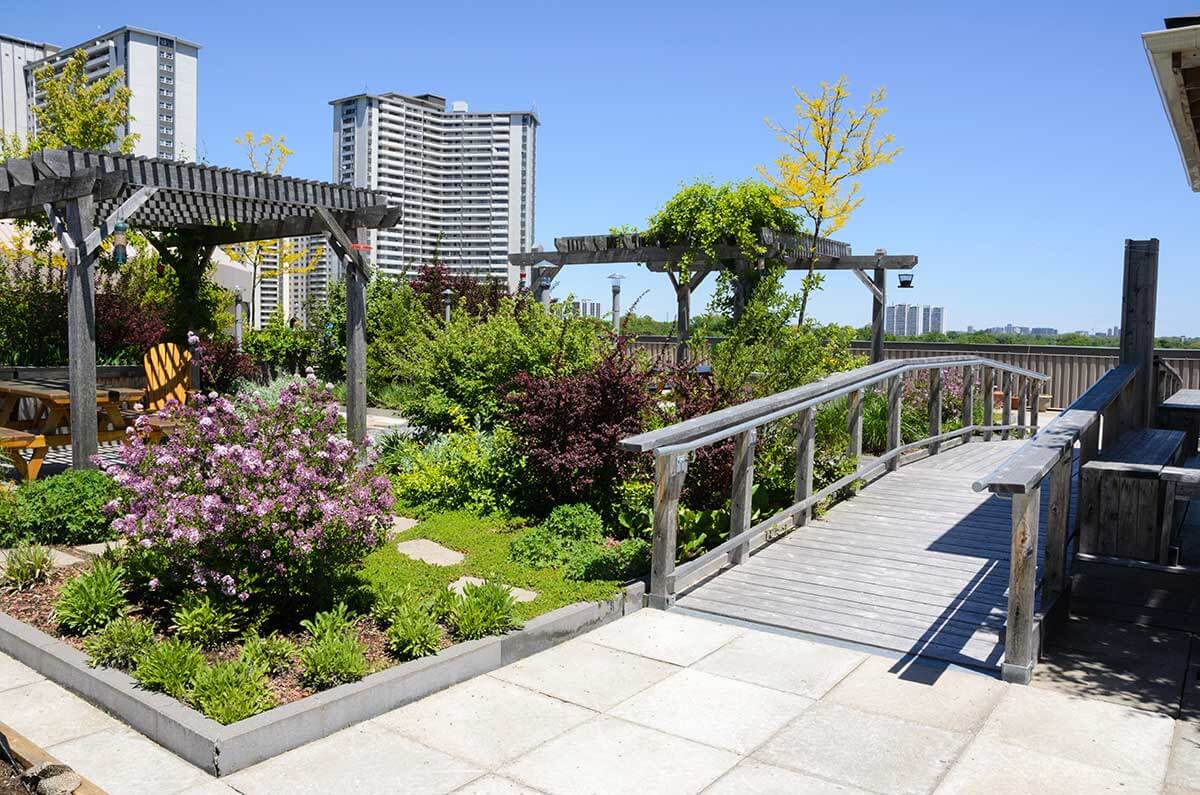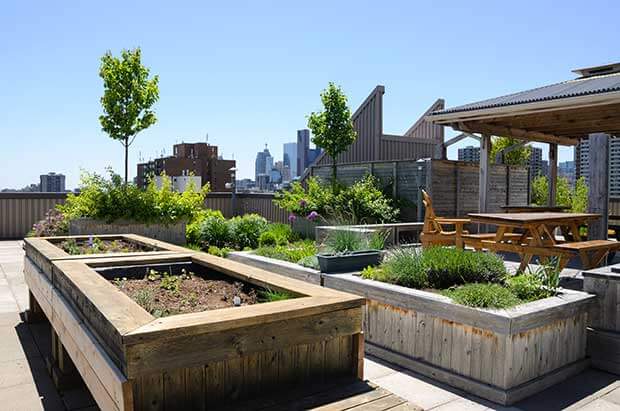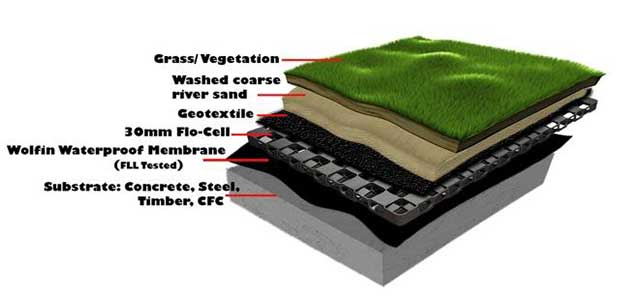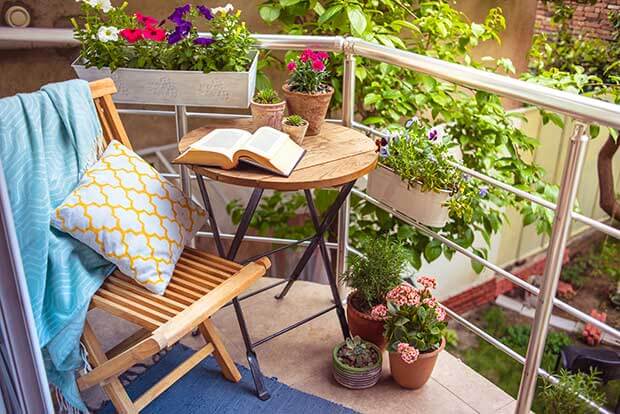
As our cities get bigger and our personal living spaces become progressively smaller, more people are turning to rooftop and balcony gardens as a way of utilising wasted space and bringing nature back to our urban environments.
Every building has a roof, so the idea of putting a garden up there should be an obvious option. Why? Because in the absence of a normal backyard, a rooftop garden can provide everything offered by a traditional garden, with the added bonus of a wonderful view.
In this article, we look at the benefits of rooftop and balcony gardens, the basic steps involved in building one and the importance of including professional waterproofing in the design to ensure the integrity of your home.
Rooftop gardens
A rooftop garden (also known as a green roof) is basically a layer of vegetation growing over a layer of substrate across a flat or sloping roof surface. The substrate layer contains drainage and landscaping materials and under this is a protective waterproof membrane, which acts as a barrier to prevent water seepage from above.
A rooftop garden offers a wide range of benefits including;
- Protection from temperature fluctuations, reducing the need for heating and cooling and lowering energy costs
- A private rooftop oasis above the urban landscape
- The opportunity to grow food and plants and enhance the biodiversity of urban areas
- Improved general air quality by trapping allergens and other airborne particles
- A reduction in stormwater runoff rates and volumes
- Added property value through the creation of additional space.
Balcony gardens
A balcony garden is a green space created on an existing balcony or veranda. It can be a series of planter beds and pots or even a vertical garden(a garden that grows upward using a trellis or other support system). Like a rooftop garden, a balcony garden offers several benefits including;
- Aesthetic appeal in an otherwise rarely used space
- A buffer against noise pollution
- A private space to retreat to
- A cooling effect during hot weather
- A food source from herbs and vegetables.
Building your garden

Creating a balcony garden can be a relatively straightforward process involving choosing the right plants and containers and setting up a water and nutrient management system. By contrast, construction of a rooftop garden is a much more complex operation, with several important elements to be considered before you can even begin.
Getting approval
Where you live is the first consideration, as if you are renting or living in a building complex run by a body corporate, you will need to get permission to build your roof garden. The suburb you live in may also be subject to building regulations and council restrictions, which you will need to find out about beforehand.
While you will probably not need a permit to create a balcony garden (unless you plan to alter the structure), most councils will require you to get approval for a rooftop garden, as there will no doubt be structural work involved.
Checking the strength and weight of your roof
The weight of your roof garden is another key factor in the equation. Even a shallow garden bed can weigh as much as 60 kilograms per square metre, so it is vital to have a qualified professional such as a builder or structural engineer check the weight capacity of your roof before you attempt to build a rooftop garden.
Your roof must be able to withstand the additional weight of building materials, plants and growing substrate, all of which can add up to as much as 250 kilograms per square metre, so your roof may have to be altered or reinforced to cope with all this extra weight.
The size and strength of your roof will determine whether you build an extensive or intensive roof garden. An extensive green roof is lightweight and designed to support only a shallow layer of vegetation and soil (no more than 20cm).
It is best suited to spaces where people are seldom going to be walking on the surface of the roof (apart from maintenance) and is designed to deliver high performance water usage and thermal advantages, while keeping overall weight low.
An intensive green roof on the other hand is a much more substantial affair, with the structural support to accommodate a deeper garden plot, a greater variety of plants, an irrigation system and even some furniture items found in a regular backyard, such as a barbeque and outdoor furniture.
Designing the garden
Presuming the boxes have been ticked with regard to structural integrity and building permission, the next step is to design your rooftop garden. Just like a normal garden, you will need to consider a range of factors when designing the layout, including;
Shade
Your rooftop garden is quite likely to be exposed to full sunlight for a lot of the day, so consider where you will put shading for those plants that need it and also for yourself. Heat not only comes from the sun, but is also radiated by the roof itself and surrounding buildings, so position your shade breaks wisely.
Wind
A roof can be an exposed area in adverse weather conditions, so try and incorporate wind breaks into your shade layout as well. Windbreaks such as lattice and trellises that disrupt the flow of wind rather than stopping it completely will be more effective, as solid windbreaks are more likely to be knocked over in strong winds.
Privacy
If you live in a built-up area, you may be overlooked by your neighbours or you may be overlooking them, so consider ways to create privacy for both of you. In this instance, strategically placed trees or sun shades are preferable to building screens or fences.
Access
Consider how you will get your materials and supplies in and out during the initial build and then how you will normally access your rooftop garden. Can you use an attic window in your house or will you be reliant on a ladder (something which will deter many people from visiting your garden)?
Electrical wiring
While electricity isn’t essential in a rooftop garden, having a waterproof power outlet installed somewhere on your roof can be useful for operating power tools and gardening equipment, and for lighting if you plan to enjoy your rooftop garden under the stars.
Irrigation
Your plants must be watered regularly, so unless you plan to cart buckets of water up a ladder every couple of days, consider an irrigation system that will do the job automatically. At the very least, install a water drum and drip irrigation to avoid having to cart buckets or drag a hose up every time you water.
Drainage
All that water has to go somewhere, so make sure you have adequate drainage to allow excess water to run off. Ideally this runoff should go into your gutters and ultimately be stored for reuse on your rooftop garden.
Waterproofing
You certainly don’t want this excess water getting into your house either, so proper waterproofing is a crucial consideration (this will covered in more detail later in this article).
Storage
Gardening requires a lot of tools and paraphernalia such as fertiliser, spades, forks, secateurs, gloves, compost, potting mix, buckets and hoses, so include somewhere to store all these things, ideally incorporating smart storage into your rooftop furniture.
Wall cladding
Wall cladding will go a long way in breaking up the space of your rooftop garden. For the layman, wall cladding allows you to incorporate a material on a wall or vertical surface to improve the aesthetic of the space. Click here to see some examples, you can use wall cladding for steps, a retaining wall, blade walls and fireplaces, just to name a few.
What plants are you going to grow?
Another major component of your rooftop garden is the plants you plan to grow in it. They will need to be hardy enough to tolerate the windy conditions and strong sunlight of a rooftop garden and ideally will not require excessive amounts of water.
For Australian conditions, consider native grasses and plants, ferns, succulents and ground covers, interspersed with small shade trees (if weight-applicable).
Ideal plants for exposed locations such as rooftops include native tussock grass (Poa labillardieri), fountain grass (Pennisetum alopecuroides), blue jellybean (Sedum pachyphyllum), cordyline, hibbertia and agave (Agave americana ‘Variegata’).
For vertical gardens on balconies, consider growing vegetables and herbs as well as plants such as bird’s nest fern (Asplenium nidus), rabbit’s foot fern (Davallia fejeensis), devil’s ivy (Epipremnum sp), baby’s tears (Soleirolia soleirolii), wax flower (Hoya carnosa), petunias (Petunia spand) and geraniums (Geranium sp).
You also need to consider the theme of your garden. Is it to be predominantly a veggie garden or will it have more of an ornamental feel, perhaps with an Australian, European or Oriental flavour? If your rooftop garden is an intensive rather than extensive one, you may even want to consider a fountain or some other water feature in its design.
The way your plants are housed is also important. Will they be mostly in pots or will you have raised garden beds or planters? Whatever you opt for, make sure you take weight into consideration and choose lightweight pots over heavy ceramics and keep soil depth to the maximum weight allowable for your roof (vegetables require at least 20 cms of soil).
You will also need to consider weight when choosing furniture and décor items for your rooftop garden. Ideally, choose plastic or fibreglass instead of wood for garden furniture and decking and grass or ground cover rather than concrete or pavers.
Waterproofing
As mentioned previously, effective waterproofing is a vital component of any rooftop garden. While some roofs are waterproofed when they are built, most need some form of treatment to prevent water seeping into the building below.
The treatment used must provide a strong protective layer that is also flexible enough to allow expansion under physical or thermal movements of the structure, without compromising water-tightness.
Older green roofs often used asphaltic bitumen as waterproofing, but because this is an organic substance, it meant that plants were eventually able to penetrate it with their roots in an attempt to find nutrients.
Being root-proof is an important characteristic of any waterproofing system and one that is synthetic rather than organic is less likely to be penetrated by plant roots.
There are two types of waterproofing systems fromProjex Group that address both of these problems, making them ideal for waterproofing rooftop gardens.
Wolfin
A flexible polyester PVC sheeting that is waterproof, UV stable, chemical-resistant and certified root-resistant. It is ideal for waterproofing roofs, balconies, decks, terraces, water tanks, and fountains. The Wolfin membrane has also been tested and certified for use in roof membrane installations for garden and planter box applications, as the roof membrane can be subjected to extreme conditions and temperatures. In fact, Projex waterproofed the rooftop garden of the Surry Hills Library with Wolfin and it is still in place today. Read more about this project here and see the graphic below to understand a typical green roof build up.

Cosmofin
A UV stable PVC waterproof membrane equipped with a central glass non-woven inlay.It is certified root-resistant, has extremely high tear and puncture resistance and is ideal for use on flat roofs, balconies, terraces, podium slabs, under tile applications, retaining walls and planter boxes.
The only way forward is up

Rooftop and balcony gardens can provide a welcoming oasis in the midst of a harsh urban landscape. They are also an excellent way to make full use of spaces that are neglected or underutilised.
And the idea of rooftop gardens is not a new one by any means.The Hanging Gardens of Babylon in ancient Mesopotamia was the first documented example and rooftop gardens were also well known in 15th century Italy; the best preserved of these being in the town of Pienza in Siena.
So, if you like the idea of being up on the roof surrounded by greenery under the sun and the stars, a rooftop garden could be just the project you’re looking for. As long as you can get permission to build it, know that your roof is strong enough to support it and that you have it professionally waterproofed, the sky is literally the limit on what you can achieve.
And forinspiration, you only have to look at the Great Wall of WA, a 230 metre long rooftop garden housing 12 residences in the bushland of Western Australia. Or Kensington Roof Gardens in the UK,home to more than 500 species of plants and shrubs. Or the Observatory Tower Penthouse in Sydney, a manicured, lush country-look garden on the twenty-fifth floor with views of the surrounding Sydney Harbour.
So what are you waiting for? Raise your eyes to the heavens, grab a ladder and tape measure and take your gardening to a whole new level with a rooftop or balcony garden. And for more information on waterproofing that works, visit Projex Group at https://projex.com.au/.